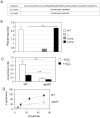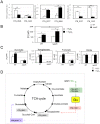Glutamate utilization couples oxidative stress defense and the tricarboxylic acid cycle in Francisella phagosomal escape
- PMID: 24453979
- PMCID: PMC3894225
- DOI: 10.1371/journal.ppat.1003893
Glutamate utilization couples oxidative stress defense and the tricarboxylic acid cycle in Francisella phagosomal escape
Abstract
Intracellular bacterial pathogens have developed a variety of strategies to avoid degradation by the host innate immune defense mechanisms triggered upon phagocytocis. Upon infection of mammalian host cells, the intracellular pathogen Francisella replicates exclusively in the cytosolic compartment. Hence, its ability to escape rapidly from the phagosomal compartment is critical for its pathogenicity. Here, we show for the first time that a glutamate transporter of Francisella (here designated GadC) is critical for oxidative stress defense in the phagosome, thus impairing intra-macrophage multiplication and virulence in the mouse model. The gadC mutant failed to efficiently neutralize the production of reactive oxygen species. Remarkably, virulence of the gadC mutant was partially restored in mice defective in NADPH oxidase activity. The data presented highlight links between glutamate uptake, oxidative stress defense, the tricarboxylic acid cycle and phagosomal escape. This is the first report establishing the role of an amino acid transporter in the early stage of the Francisella intracellular lifecycle.
Conflict of interest statement
The authors have declared that no competing interests exist.
Figures







 means the ratio (H2O2-treated/non-treated) is lower in the mutant strain than in the wild-type strain; ↗ the ratio (H2O2-treated/non-treated) is higher in the mutant strain than in the wild-type strain. In the absence of external glutamate (e.g. in standard chemically defined medium), the pool of glutamate present in the bacterial cytoplasm may be synthesized either from oxoglutarate, glutamine, GSH or even proline (according to KEGG metabolic pathways).
means the ratio (H2O2-treated/non-treated) is lower in the mutant strain than in the wild-type strain; ↗ the ratio (H2O2-treated/non-treated) is higher in the mutant strain than in the wild-type strain. In the absence of external glutamate (e.g. in standard chemically defined medium), the pool of glutamate present in the bacterial cytoplasm may be synthesized either from oxoglutarate, glutamine, GSH or even proline (according to KEGG metabolic pathways).Similar articles
-
A method for functional trans-complementation of intracellular Francisella tularensis.PLoS One. 2014 Feb 4;9(2):e88194. doi: 10.1371/journal.pone.0088194. eCollection 2014. PLoS One. 2014. PMID: 24505427 Free PMC article.
-
The early phagosomal stage of Francisella tularensis determines optimal phagosomal escape and Francisella pathogenicity island protein expression.Infect Immun. 2008 Dec;76(12):5488-99. doi: 10.1128/IAI.00682-08. Epub 2008 Oct 13. Infect Immun. 2008. PMID: 18852245 Free PMC article.
-
The complex amino acid diet of Francisella in infected macrophages.Front Cell Infect Microbiol. 2015 Feb 6;5:9. doi: 10.3389/fcimb.2015.00009. eCollection 2015. Front Cell Infect Microbiol. 2015. PMID: 25705612 Free PMC article. Review.
-
Characterization of a Unique Outer Membrane Protein Required for Oxidative Stress Resistance and Virulence of Francisella tularensis.J Bacteriol. 2018 Mar 26;200(8):e00693-17. doi: 10.1128/JB.00693-17. Print 2018 Apr 15. J Bacteriol. 2018. PMID: 29378894 Free PMC article.
-
Importance of Metabolic Adaptations in Francisella Pathogenesis.Front Cell Infect Microbiol. 2017 Mar 28;7:96. doi: 10.3389/fcimb.2017.00096. eCollection 2017. Front Cell Infect Microbiol. 2017. PMID: 28401066 Free PMC article. Review.
Cited by
-
A Small Protein Associated with Fungal Energy Metabolism Affects the Virulence of Cryptococcus neoformans in Mammals.PLoS Pathog. 2016 Sep 1;12(9):e1005849. doi: 10.1371/journal.ppat.1005849. eCollection 2016 Sep. PLoS Pathog. 2016. PMID: 27583447 Free PMC article.
-
Role of Mitochondrial Retrograde Pathway in Regulating Ethanol-Inducible Filamentous Growth in Yeast.Front Physiol. 2017 Mar 29;8:148. doi: 10.3389/fphys.2017.00148. eCollection 2017. Front Physiol. 2017. PMID: 28424625 Free PMC article.
-
Defining the Metabolic Pathways and Host-Derived Carbon Substrates Required for Francisella tularensis Intracellular Growth.mBio. 2018 Nov 20;9(6):e01471-18. doi: 10.1128/mBio.01471-18. mBio. 2018. PMID: 30459188 Free PMC article.
-
Metabolomics insights into the interaction between Pseudomonas plecoglossicida and Epinephelus coioides.Sci Rep. 2022 Aug 3;12(1):13309. doi: 10.1038/s41598-022-17387-6. Sci Rep. 2022. PMID: 35922642 Free PMC article.
-
The Ability to Acquire Iron Is Inversely Related to Virulence and the Protective Efficacy of Francisella tularensis Live Vaccine Strain.Front Microbiol. 2018 Apr 4;9:607. doi: 10.3389/fmicb.2018.00607. eCollection 2018. Front Microbiol. 2018. PMID: 29670588 Free PMC article.
References
Publication types
MeSH terms
Substances
LinkOut - more resources
Full Text Sources
Other Literature Sources

